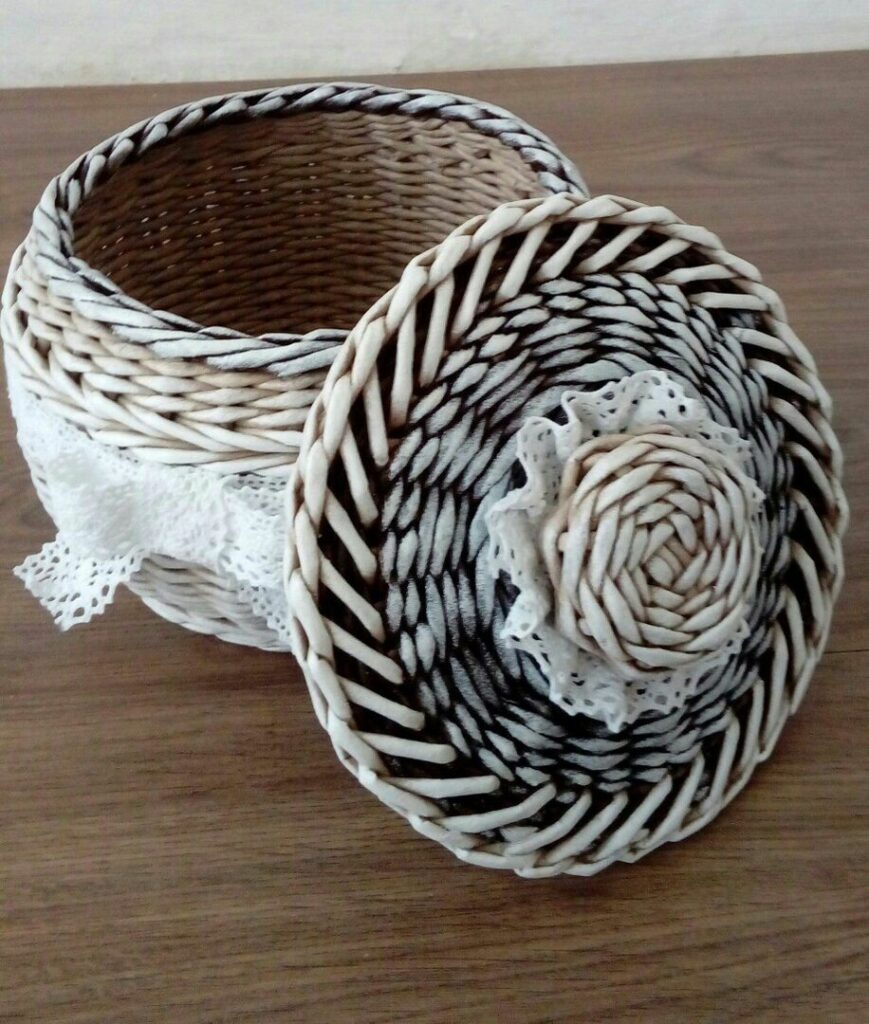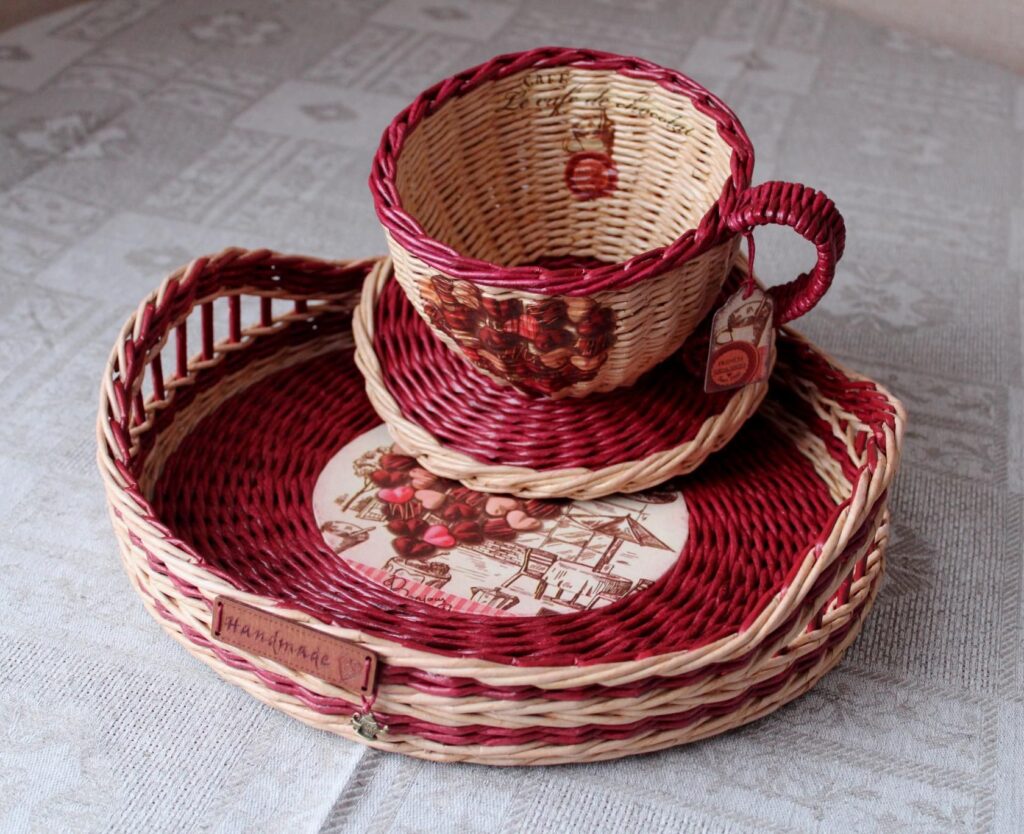Dyeing paper tubes is a very important stage, at least because if you do it correctly, the weave will be pleasant, and if you dye incorrectly, you will have a desire to burn baskets, tubes, paper and, with particularly unsuccessful recipes, neighbor’s sheds. What components are needed and why they are needed, you can read here.
Now you could easily mix a decent jar of a pleasant color to the eye. What to do next?

I’ll be a nerd, but I’ll remind you to first prepare a place where you’ll be painting the tubes. The case is quite dirty, so stock up in advance enough film to make everything, because to make repairs after each coloring is enough overhead. Despite the fact that the main film you make, the paint drops will still fly in all directions, so prepare rags and cleaners to not run around the apartment in their search, in case of what. Well, to save from paint is not only an apartment, but also a loved one, so it is worth to get clothes that will be mercilessly gagged, varnishes, colliers, morticians and some gods know what else.
Well, an obligatory part of the painting – it’s gloves, take care of your hands and never without gloves do not paint, let’s listen to the recommendations of manufacturers at least sometimes and work strictly in gloves. My longest-serving nitrile gloves are from Frecken Bock, they are strong enough, thin enough and yet a pretty blue color. Love your pens and don’t paint without gloves.
Well, so far, all these things are more from painting than painting. So what’s it gonna take for her? First of all, you need to decide how you will paint, because there are two methods of painting: brush and dipping. Both have their advantages and disadvantages.
Let’s start with painting with a brush. The main advantage – is the relative economy of this method, the composition for coloring does not fly away as it happens when dipping. Another plus is that this method is cleaner, there is a chance that you will not dirty the whole apartment, but only part of it. And when you paint with a brush, you better control how well your tubes are painted. It’s a huge disadvantage, one that outweighs any advantage to me, it’s a terrible time consuming method. It’s not so noticeable if you just paint two or three or four hundred times a week or two, but if you paint large amounts, these brushes are likely to drive you crazy.
I’m biased, of course, as always. My favorite is the dip dyeing method. Why is that? Because it’s very fast. It’s very fast, you take the bundle, then the other one, then the next one, and you’ve already dyed a bunch of tubes. What I like about this method is that the tubes are completely soaked in paint. It’s not for nothing that we’ve added so many primers and impregnations. The downside is usually the need for a container. Some paint vertically in wide tubes – this method is really very colorful and expensive. I paint in the usual low baking tray not very large portions. What are the disadvantages of this method? First of all, it takes more paint to paint, secondly, you need a container for painting and you definitely need to pour from can to pallet and back, many people do not like such a pastime too much. There’s one more thing in particular. I haven’t encountered this, but I’ve read several times that some people have experienced the fact that when they dip the tubes, the curl hasn’t glued together, while using a brush, they haven’t encountered this problem. I have not caught this connection, so I have no reason not to use this method. But it’s still a point to keep in mind.
So, you need to paint it:
A film with which you at least minimally hide the apartment from the droplets. Maturity depends on your accuracy and novelty of repair.
The container in which the paint will be diluted. I used disposable plastic glasses for a long time. Now I switched to ordinary glass jars – they were more comfortable and they are not so easy to turn over.
The spoon you’re gonna use to stir the compound. Either a stirring stick. Keep in mind at once that stirring takes a long and hard time.
Gloves. Mastkhev, even if you like to wash your hands of paint for half an hour, still take care of your health: most manufacturers do not recommend contact with the skin.
Brush. Even if you are going to paint with dip, you still keep it close, if you want to paint the composition completely, you will need it.
The container in which you’re going to paint. It depends on the method and the volume you’re painting with. If you’re not going to paint with dip, you just need the film. If you like to weave huge boxes on the fridge boxes, you should find a bigger container. I don’t need a deep tray, but since it’s enameled, it’s easy to wash.
And the next moment that follows the staining, without any break, is drying. How do you dry the tubes after painting? There’s a lot of tricks and tricks that our craftsmen have tried and invented.

Someone dries the tubes by putting them in a thin layer around the apartment, it’s only good if you don’t have кота\собаки\ребёнка and you’re not limited to empty square meters. Somebody’s building crazy jengi that look like the towers of Babel in height. Somebody dries on office racks or egg trays, saying hello to Salmonella every time. Either way, I look at all these methods as an unnecessary complication. They’re all eating up your time. I’m just drying on film (some people do it on paper to soak up the extra paint), just in a bunch, remembering to stir, I’ve already written here that I add soap to the solution so that the tubes don’t stick together too much.
Just find the recipe that’s right for you and remember to stir until the tubes stop sticking. There will be an article about how I paint soon, too, because I have found some new tricks for myself and I want to share.